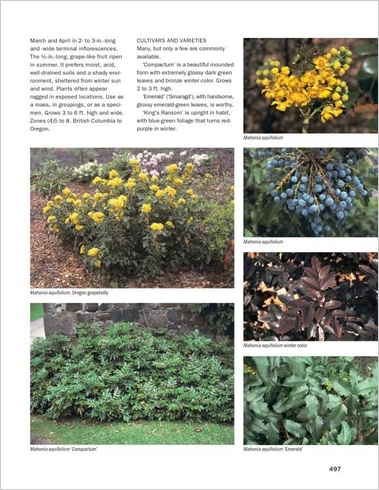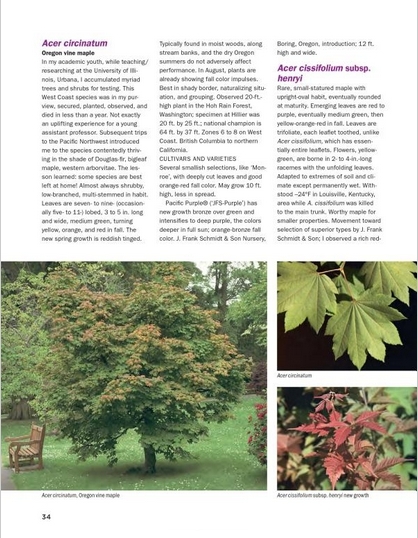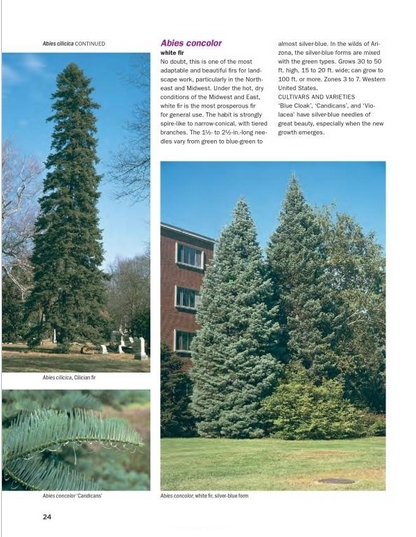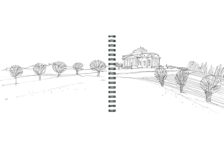Most landscape architects are likely already familiar with horticultural reference book author Michael Dirr, a professor of horticulture at the University of Georgia and author of the seminal Manual of Woody Landscape Plants. In many ways, that book is the gold standard for a plant reference book and many landscape architects likely already have a copy on their bookshelves. So, if that’s the case, is a copy of Dirr’s Encyclopedia of Trees and Shrubs (2011; Timber Press; 952 pp.; $79.95) truly necessary or simply redundant?
Dirr’s Encyclopedia of Trees and Shrubs by Michael Dirr, p. 34. Source: Timber Press.
The answer, of course, will depend on the individual. But while Encyclopedia covers the same general topic as Manual, its purpose and format are different. The first thing that the reader will notice is what a handsome volume it is; whereas Manual focused on plant identification with line drawn illustrations of foliage, fruit, and bark, Encyclopedia is lushly illustrated with full-color photographs, often of the whole plant or groups of plants as opposed to close-up shots of identification details.
Dirr’s Encyclopedia of Trees and Shrubs by Michael Dirr, p. 24. Source: Timber Press.
The ubiquitous presence of full-color photos should tip the reader off as to what the purpose of Encyclopedia is as compared to Manual. It’s more of a guide to plant selection than a strictly scientific reference book. While the book is organized in a similar fashion – alphabetically by genera with entries for specific species – the entries themselves are slightly different. While each entry includes often abbreviated scientific information, they’re largely written in a more informal and avuncular style than was Manual. The focus here is less on rotely going through a set of scientific criteria for each plant as it is on providing basic scientific information along with practical and sometimes personal commentary on the plant, its propogation and use, and even suggestion for aesthetic decisions in terms of planting.
 Dirr’s Encyclopedia of Trees and Shrubs by Michael Dirr, p. 497. Source: Timber Press.
Dirr’s Encyclopedia of Trees and Shrubs by Michael Dirr, p. 497. Source: Timber Press.
While the number of genera it contains is 380, the total number of species and overall amount of information here is less than was in Manual. However, it contains more informal advice on plant selection and propogation, gleaned from Dirr’s decades of experience which might prove to be invaluable. Moreover, the inclusion of the photographs and the more readable text make the book a pleasure to be hold, meaning that you are more likely to pull the book and flip through it for the fun of it as opposed to only pulling it off the shelf when you have something specific to look up.
Dirr’s Encyclopedia of Trees and Shrubs by Michael Dirr, p. 511. Source: Timber Press.
As such, it’s something of a bridge between the hobbyist and the professional. While it’s no doubt professionals will enjoy the information and find much of it useful, its presentation and format are such that it will appeal to serious hobbyists as well. With the lush packaging and abundance of attractive photography, it’s also the kind of coffee table book that professionals might leave on a table for clients to flip through. Appendices also include tables for plant selection for specific characteristics such as flower color, salt tolerance, and habit shape, making Encyclopedia both a useful and enjoyable horticultural reference book.
Let us know what you think!
Have you read this book? What’s your opinion?
What’s your favorite horticultural reference book?
What websites or applications do you use as horticultural references?
Published in Blog















Annie Bergelin
Thanks so much for this overview. I’ve been eyeing the book at my local bookstore, wondering if I should invest in it. Now I think I will.
Cheers!
Ryan A. Waggoner
Truly a great book and one that I regularly use in addition to Manual. I’ve found the best uses for it are during the design phase making plant selections as well as in meetings with clients to give them a better idea of the plants’ sizes, forms and textures. To me, this is hands down the best illustrated horticultural book I have come across, and well worth the purchase.
As far as horticultural websites, the Missouri Botanical Garden has been my favorite (found here). For finding plant material, Plant Ant is a quickly growing website filling with more and more nurseries by the week (found here). I even downloaded their app, but unfortunately it is for nurseries to update plant material as opposed to locating them. Hopefully they will expand upon their app to make it more user friendly for us. A couple more fun websites are:
http://plantlust.com/
http://www.treebrowser.org/
http://davisla.wordpress.com/
More horticultural based, university run websites:
http://www.saylorplants.com/
http://www.hort.uconn.edu/plants/
http://ohioline.osu.edu/hyg-fact/1000/index.html
http://hort.ufl.edu/database/index.shtml
Great selection and read, looking forward to more reviews soon!
Audra Lofton, Hon. ASLA
Passing this along from Dirr that many of my LA’s use.
https://itunes.apple.com/us/app/dirrs-tree-and-shrub-finder/id410437012?mt=8
G. Ryan Smith
This comment has been moderated.
Thank you for your comments and interest in further articles. I’d like to invite you to visit my Landscape Architecture topic on examiner.com and subscribe to receive story alerts there. http://www.examiner.com/landscape-architecture-in-national/ryan-smith
G. Ryan Smith
“If you’re interested in planning and zoning, check out my topic page and subscribe on examiner.com http://ning.it/16v0VLv“